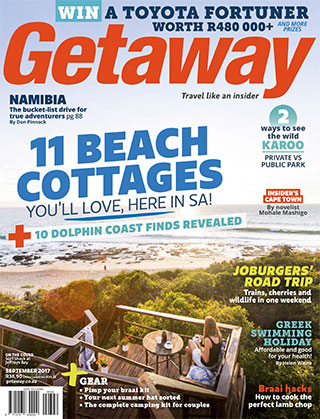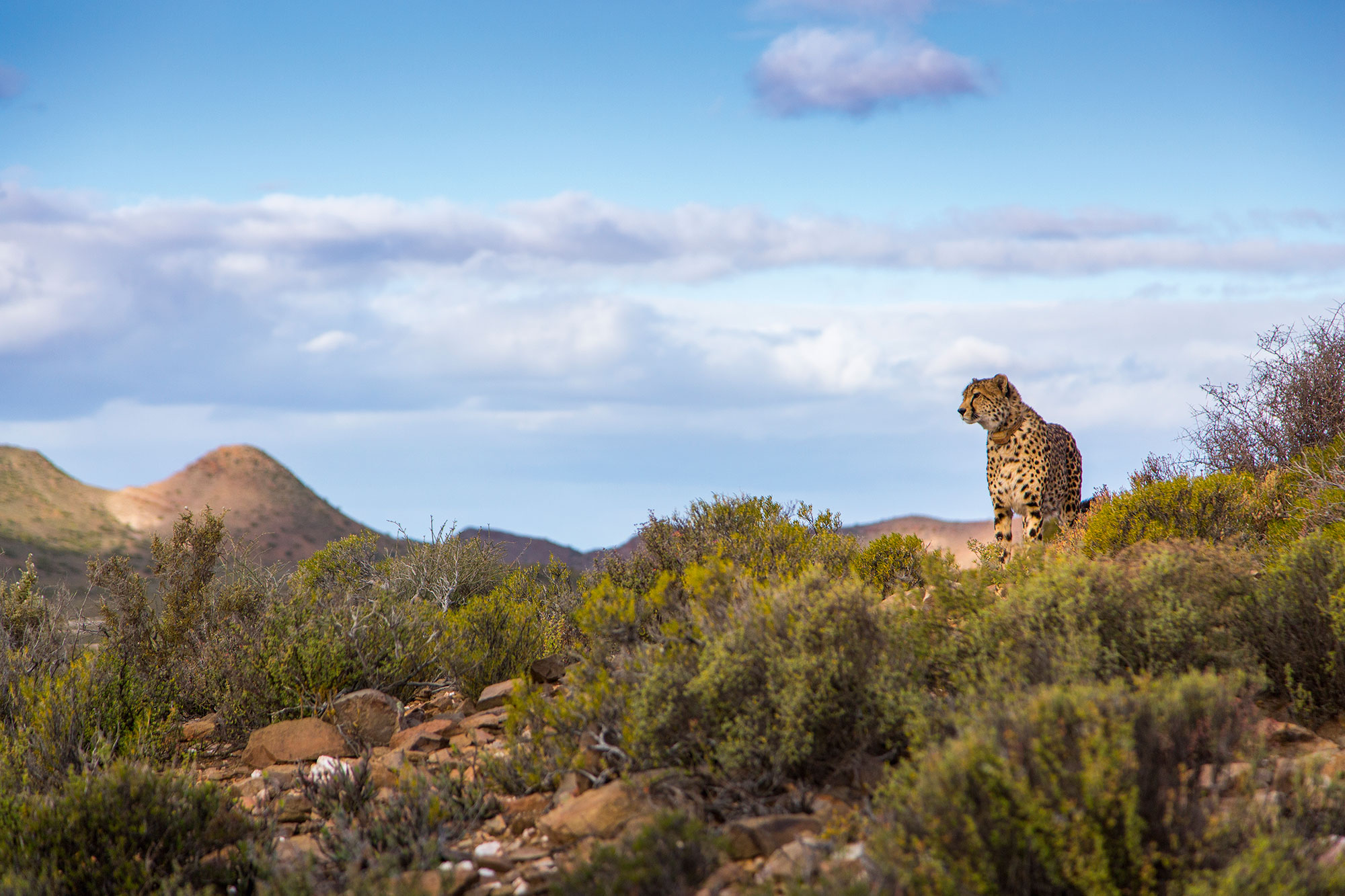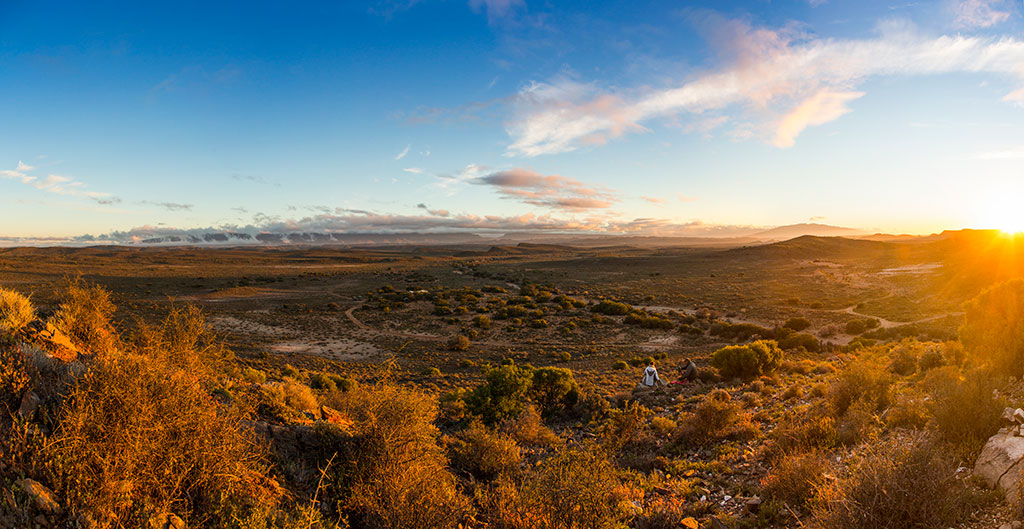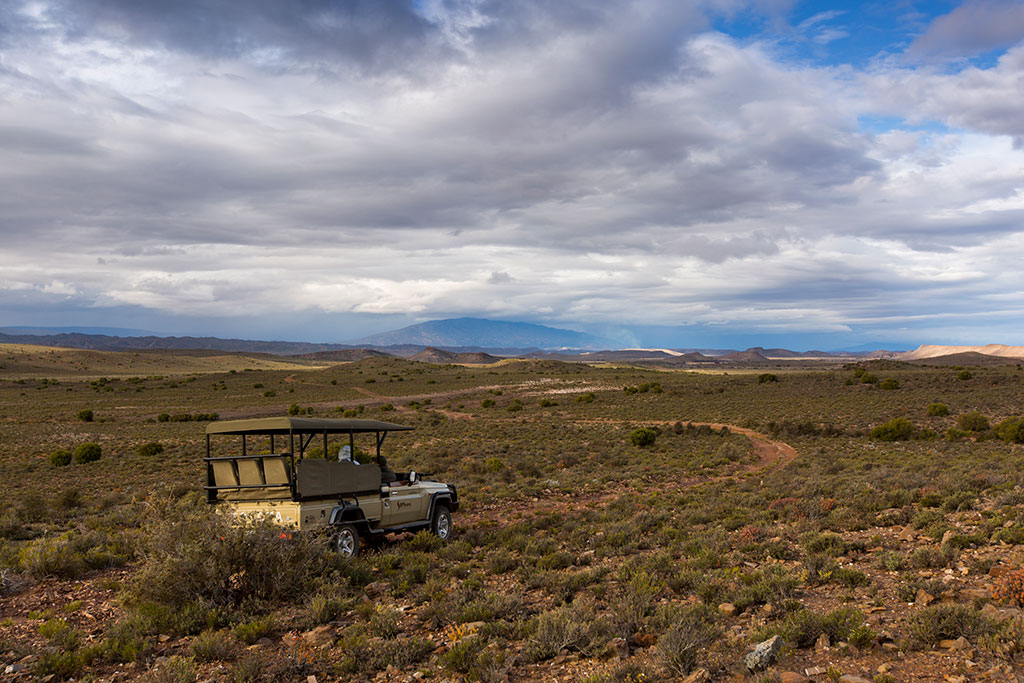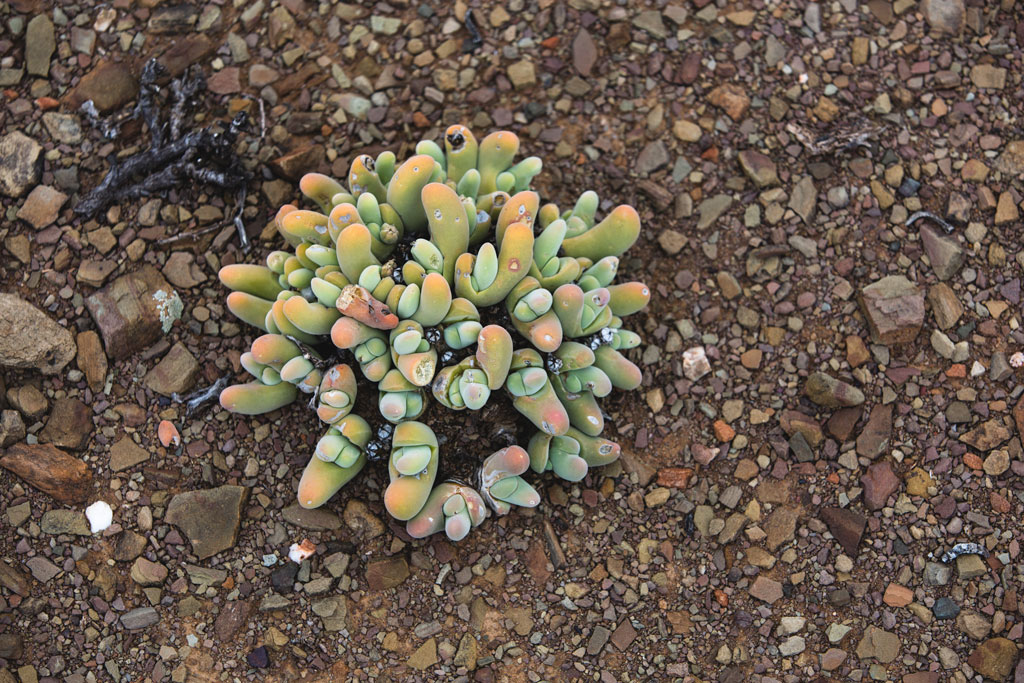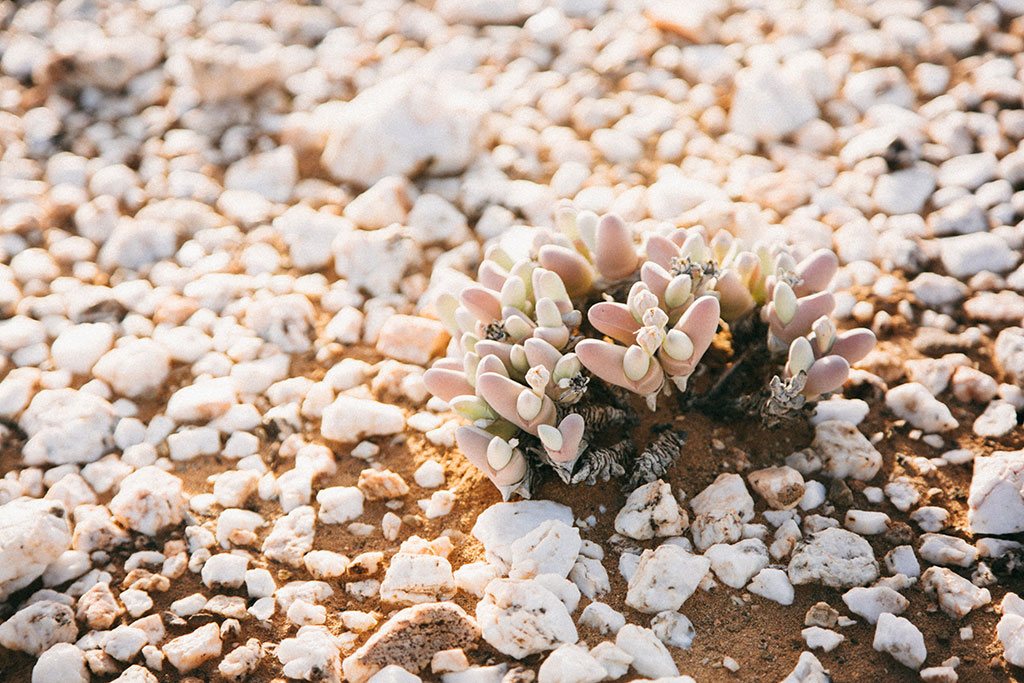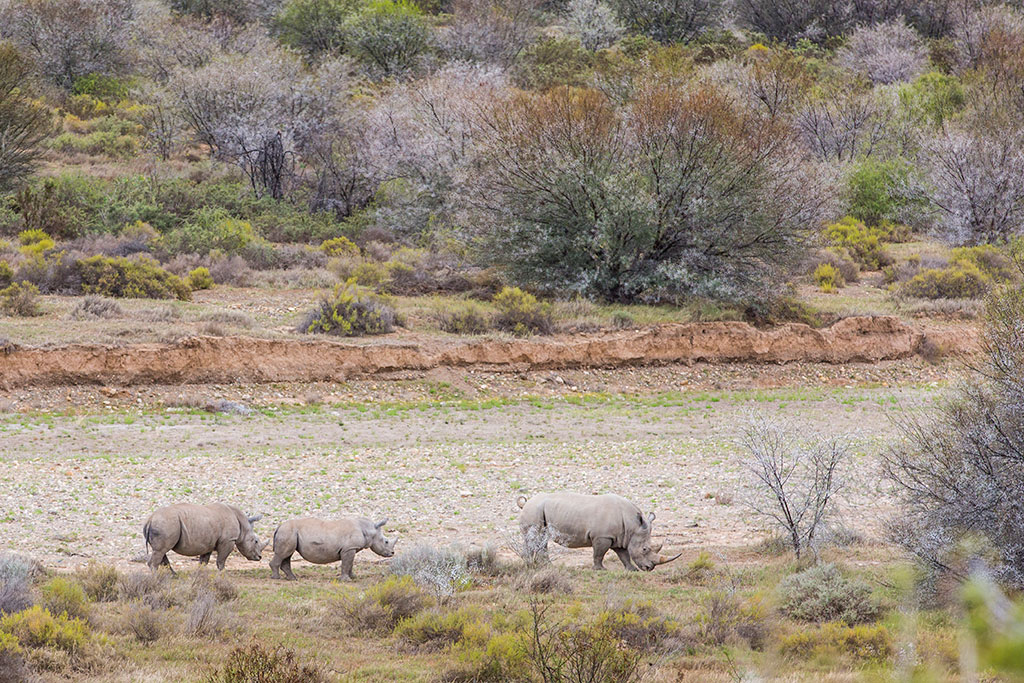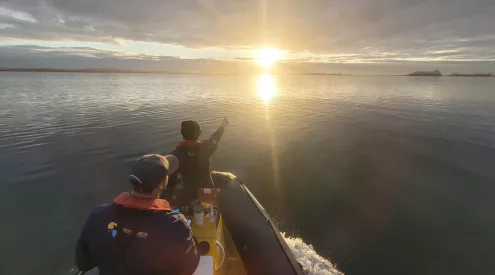If you’re interested in wildlife, a good guide is like someone filling in the outlines of a colouring book.
Also, they’ll take you to sites of interest. I particularly liked Sanbona’s approach of focusing on the environment and ecosystems as opposed to big game. I’d highly recommend the Explorer Camp, which focuses on walking tours, but it is a pricey piece of travel.
Also read: How to have an affordable free range Klein Karoo stay
When times are hard and food is scarce, a mother red-knobbed coot has a plan. Should she have too many chicks, she’ll take them out for a turn on the water one day and, while the little coterie is paddling furiously along, she’ll turn her attention to the weakest and push it under the water, holding it down until it drowns.
It’s stories like this that add a thread of blood-hot colour to what can otherwise seem like monotonous brown landscape. Well, I could do without knowing that, you might think; that’s brutal. But we’re leaning forward, hanging on every word of safari noir, wondrous at Mother Coot’s pitiless practicality.
That’s a trick of this land. At first glance, its most spectacular aspect seems to be the Cape Fold mountains, which rise up from the plains as if some godly sculptor has reached down and pleated and pinched them into shape. The vegetation that covers the plains below seems an uninspired khaki, but that’s when you need to step down off the safari vehicle and get behind the back of Casper Bester, who heads up the Explorer Camp at Sanbona Wildlife Reserve. Then a wonderland of colour will open up at your booted feet.
For instance, crassulas: there are about 200 species in the Karoo. One of the things that makes them distinct as a species is the neatly arranged, perfectly symmetrical leaves on a stem. Casper points out a Crassula deltoidea. Its plump leaves are depicted as grey-green in Plants of the Klein Karoo, but as we clamber amongst the rocks we see specimens with leaves in varying shades of pink, others in purple, and yet more in tart orange edged in neon red, the little punks. They occur here on the mountainsides on what’s called the ranteveld, Casper explains, where the biggest diversity of plants is found.
Gibbeaum pubescens, just one of the many amazing plants to discover on a walk through the Klein Karoo. There’s always time to stop and search under a bush to see what you might find, and a good guide is essential for that. Photo by Teagan Cunniffe.
Just down the slope in the khakibos and around a bend from where we’re standing, still in wonder at the crassulas, is the Sanbona Explorer Camp, situated within a semi-circle of hills. It’s a small and cosy camp, sleeping only six guests and two staff (Casper and right-hand man Desmond Jaggers). There’s a bedouin-style communal tent close to a clearing of sand. Central to it is a big firepit, around which we huddle that evening. On the second night it’s so cold we sit in it. Charmingly, there’s a shower built into an ancient Karoo boer-bean tree. We’re grateful for the hot water because the wind that cuts across the landscape is biting.
We feel it when we get up in the dark to see the sunrise. We hike north-east into a bed of Klein Karoo quartz vygieveld. Soon we’re down on our haunches, hunting for a unique and rare little ‘vetplant’ Casper wants to show us called a khaki button (Crassula columnaris). The Boers named it that, he says, because they thought it looked just like the buttons on British soldiers’ jackets. And there it is, looking for all the world just as he described it. He points out haaibekkies (Gibbaeum pubescens) and – chuckle –kinderpieletjies (Augea capensis). He shows us how, should we be caught in this arid land with no water, we can conjure up some, given the right plants, sun and a bit of boer-maak-’n-plan.
We saw this cow and calf from a ridge overlooking the riverbed, and they were smartly chased off by another territorial male. Photo by Teagan Cunniffe.
We crack on over the plain and down into the riverbed, talking about Creation and religion because grand landscapes inspire such conversations, when suddenly he stops. He thinks there might be a rhino close by, and slips the gun off his shoulder. We creep along, strung tight, and then there it is across the dry sandy bed, soaking up the sun like a living, breathing flesh-and-blood tank. He’s astounding and massive and solid and we can even smell him. The richness of this experience, being so close and on foot, in front of this enormous being standing baking under the vast blue sky, makes me feel smug about my life choices.
And it gets better. On a drive the next day, Casper spots something on a hillside and pulls over. A cheetah. To my surprise, he gets off the vehicle. We march off at a smart pace behind him across the gwarrieveld, then start up the bank, keeping the cheetah in our sights. She does the same, still and focused, but stays put.
We get closer and closer still. It’s only at about eight metres away that we stop. I can hardly breathe. She stares at us, looks away and yawns. Then, quick as a kitten, she shoots out a paw and flicks up a stone. It flips over her head, she rolls head-over-body and catches it as it skitters down. Then she sits up, cat-cool, as if to say: well, that bit of crazy didn’t just happen.
Early morning on a ridge in Sanbona. I particularly liked Sanbona’s approach of focusing on the environment and ecosystems as opposed to big game. Photo by Teagan Cunniffe.
But it did. And the reason I could witness it has another good story behind it. Decades ago, cheetahs went through a major genetic bottleneck and there were very few in the wild. What became crucial was that Acinonyx jubatus could fend for themselves in the wild. Mostly, says Paul Vorster, general manager at Sanbona, they came from wildlife farms, so in game reserves chances are they’d get killed by lions.
Sanbona first bought their cheetahs in 2003. The first lot didn’t fare well, but one pregnant female did. To observe her, Paul spent days of months following her at a distance, and then one day she allowed him closer. She’d become habituated. She had three cubs and Paul was still able to sit and observe them. Now Sanbona’s big cats are sought-after, a fact he’s very proud of.
‘Our cheetah have contributed to the meta-population in a population project that was coordinated by the Endangered Wildlife Trust. They’re sought-after for many reasons: they’re approachable, so you can monitor them; they can hunt in very tough environments – they’re very efficient hunters; they’re adaptable; and they’re living here hand-in-hand with a lion population, so they’re lion aware.’
Sanbona’s Explorer Camp is a number of tents set in a sandy patch that looks out onto incredible mountains. The communal lounge is wonderfully romantic, with kilims and cushions and chairs. Photo by Teagan Cunniffe.
Sanbona’s conservation ethics are driven by the bigger conservation picture, beyond its own borders. Being aware of the criticism, or scepticism at best, from environmentalists about bringing in big game to this plant-sensitive area, particularly elephant, which are perceived to be destructive if unchecked, Sanbona’s conservation department has set up a number of monitoring programmes, one being exclusion plots to observe the impact. It’s headed up by Paul’s wife, ecologist Liesl Vorster.
The animals used to be here, say Liesl and Paul. Proof of this can be found in rock art in the area, as well as historic records from hunters and other visitors. ‘We’re trying to recreate what was here 300 to 3000 years ago, what the San people would have experienced, seen and lived in,’ says Paul. The problem is that long ago human habitation didn’t hinder the free movement of wildlife, which would have moved out of an area when resources were scarce, as they are in the dry season.
Now the reserve has to rely on other methods of management, such as animal translocation, possible contraception, expansion, and monitor, monitor, monitor. ‘But we’re involved and engaged in the conservation conversation,’ says Liesl. Should they see negative effects, they will adapt, she says, make the changes that need to be made and manage accordingly.
The Explorer Camp is set along a dry riverbed, and there is a very, very beautiful little secluded picnic site they’ll set up if you ask nicely. Photo by Teagan Cunniffe.
Recently, the reserve entered into a stewardship programme with CapeNature, and is about to receive perpetual Protected Area status. This is good news for the broader Klein Karoo region. Sanbona is adding to the conserved natural space, and there is even some talk of expanding these protected areas, linking clusters of land to create a massive, unfenced integrated landscape. ‘The primary objective is sustainable conservation,’ says Paul.
On our final morning, rounding a bend, we come upon the safari-goer’s wet dream: a fresh kill, so fresh we can still see the drag marks of the young kudu’s hooves as it was pulled down. Around it are four young male lions. They clock us, but turn back to their bloody deed, growling with such gutteral grumbles that I feel it in my chest and can imagine death, and recall the first story of the macabre Mother Coot. This is what this place has delivered on a silver plate: exquisite colour and intricate ecosystems and steady blue skies versus the stories of the shock and brutality and blood of safari noir.
Plan your trip to Sanbona Wildlife Reserve
Getting there
Sanbona is about 43km from Montagu on the R62. Turn left at the ‘Die Vlakte’ sign, then it’s another 7km on a dirt road to the main gate.
When to go
Spring is best for flowers, but it can be nippy at night. Summer is dry and can get really hot (into the 40s) but camping is lovely then. Around March is probably the happiest medium, when the days are hot but it’s starting to cool. Winters can be quite wet.
Need to know
Take good jackets and warm pants and gloves – the wind-chill factor can be intense. Plus a hat and sunblock, always. You’ll need good walking shoes, and if you’re a keen photographer, this is a chance for both beautiful landscapes and detailed micro photography of plants.
Stay here
Explorer Tented Camp (summer only) is small, intimate and charming, and offers the privilege of seeing wildlife on foot. It’s also the most reasonably priced option, from R4101 per person sharing all inclusive. Getaway readers will get a 10% discount (state you’re a reader when booking), valid for this season (October 2017 to April 2018).
Sanbona also has more upmarket, all-inclusive options:
Dwyka Tented Lodge is spectacular and set in front of a sheer cliff. From R5828 per person.
Gondwana Family Lodge has a lovely relaxed atmosphere and, as its name suggests, is great for kids. From R5411 per adult sharing, children from R2705.
Also read: 23 of Getaway’s favourite affordable Karoo cottages under R500
Do this
Walking safaris are truly the best thing, and can make a trip to a Big Five reserve so much more exciting. The fact that the environment dictates fewer animals makes it a less threatening space, and you can stop and look at the detail. Ask if it’s possible to see the cheetahs, but note that the guides will not chase after game; they take the approach, correctly, that they will be guided by the wildlife.The boat safari was the bomb for birding. We spent a good while on the water identifying fowl in the reeds surrounding the dam, and as we got to one end, the elephants came over the horizon.
Stargazing – the Karoo, after all. At Explorer Camp you’ll be under a blanket of stars, and Casper will tell you stories about them.
This awesome list of beautiful beach cottages first appeared in the September Getaway issue.
Our September issue features 11 amazing beach cottages, two ways to see the Klein Karoo, a windswept 4X4 drive in Namibia, our guide to swimming in Greece and much more!
